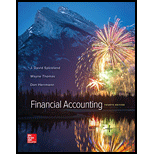
Concept explainers
Calculate and interpret ratios (LO7–7)
Sub Station and Planet Sub reported the following selected financial data ($ in thousands). Sub Station’s business strategy is to sell the best tasting sandwich with the highest quality ingredients. Planet Sub’s business strategy is to sell the lowest cost sub on the planet.
| Sub Station | Planet Sub | |
| Net sales | $108,249 | $62,071 |
| Net income | 25,922 | 3,492 |
| Total assets, beginning | 75,183 | 38,599 |
| Total assets, ending | 116,371 | 44,533 |
Required:
1. Calculate Sub Station’s return on assets, profit margin, and asset turnover ratio.
2. Calculate Planet Sub’s return on assets, profit margin, and asset turnover ratio.
3. Which company has the higher profit margin and which company has the higher asset turnover? Is this consistent with the primary business strategies of these two companies?
1.
To calculate: The S company’s return on assets, profit margin and asset turnover for Sandwiches.
Explanation of Solution
Rate of return on total assets:
Rate of return on the total assets is the ratio of the net income, and interest expense to the average total assets. The rate of return on total assets measures the efficiency of the business. It measures how efficiently the business is using its total assets in generating the income.
The rate of return on the total assets is calculated as follows:
- Determine the return on assets ratio:
The return on assets ratio is determined as follows:
Determine the average total assets:
Hence, the return on asset ratio is 34%.
- Determine the profit margin ratio:
The profit margin ratio is determined as follows:
Hence, the profit margin ratio is 24%.
Determine the asset turnover ratio:
The asset turnover ratio is determined as follows:
Hence, the asset turnover ratio is 1.1 times.
2.
To calculate: The P company’s return on assets, profit margin and asset turnover for Sandwiches and Smoothies.
Explanation of Solution
- Determine the return on assets ratio:
The return on assets ratio is determined as follows:
Determine the average total assets:
Hence, the return on asset ratio is 8.40%.
- Determine the profit margin ratio:
The profit margin ratio is determined as follows:
Hence, the profit margin ratio is 5.62%.
- Determine the asset turnover ratio:
Determine the asset turnover ratio is determined as follows:
Hence, the asset turnover ratio is 1.50 Times.
3.
To comment: On the ratios.
Explanation of Solution
- Company S has higher profit margin when compared to Company P.
- Company P has higher asset turnover when compared to Company S.
- Company S produces innovative products. Hence it has higher profit margins. Company
P emphasizes high sales turnover as it has competitive pricing strategies.
Want to see more full solutions like this?
Chapter 7 Solutions
Financial Accounting
- I need help finding the accurate solution to this general accounting problem with valid methods.arrow_forwardCan you explain the correct methodology to solve this general accounting problem?arrow_forwardI am trying to find the accurate solution to this general accounting problem with the correct explanation.arrow_forward
 College Accounting (Book Only): A Career ApproachAccountingISBN:9781305084087Author:Cathy J. ScottPublisher:Cengage Learning
College Accounting (Book Only): A Career ApproachAccountingISBN:9781305084087Author:Cathy J. ScottPublisher:Cengage Learning
